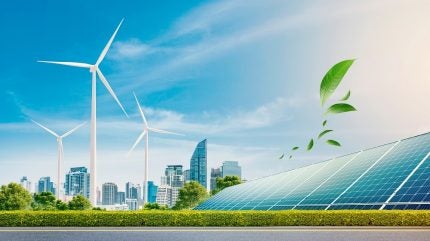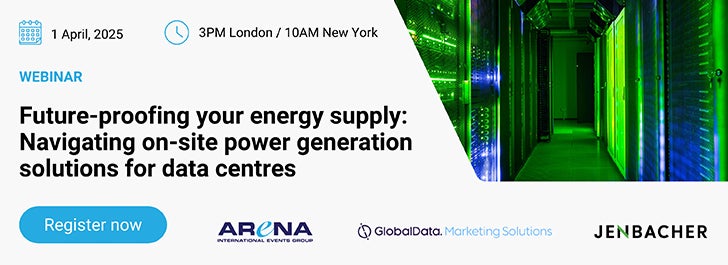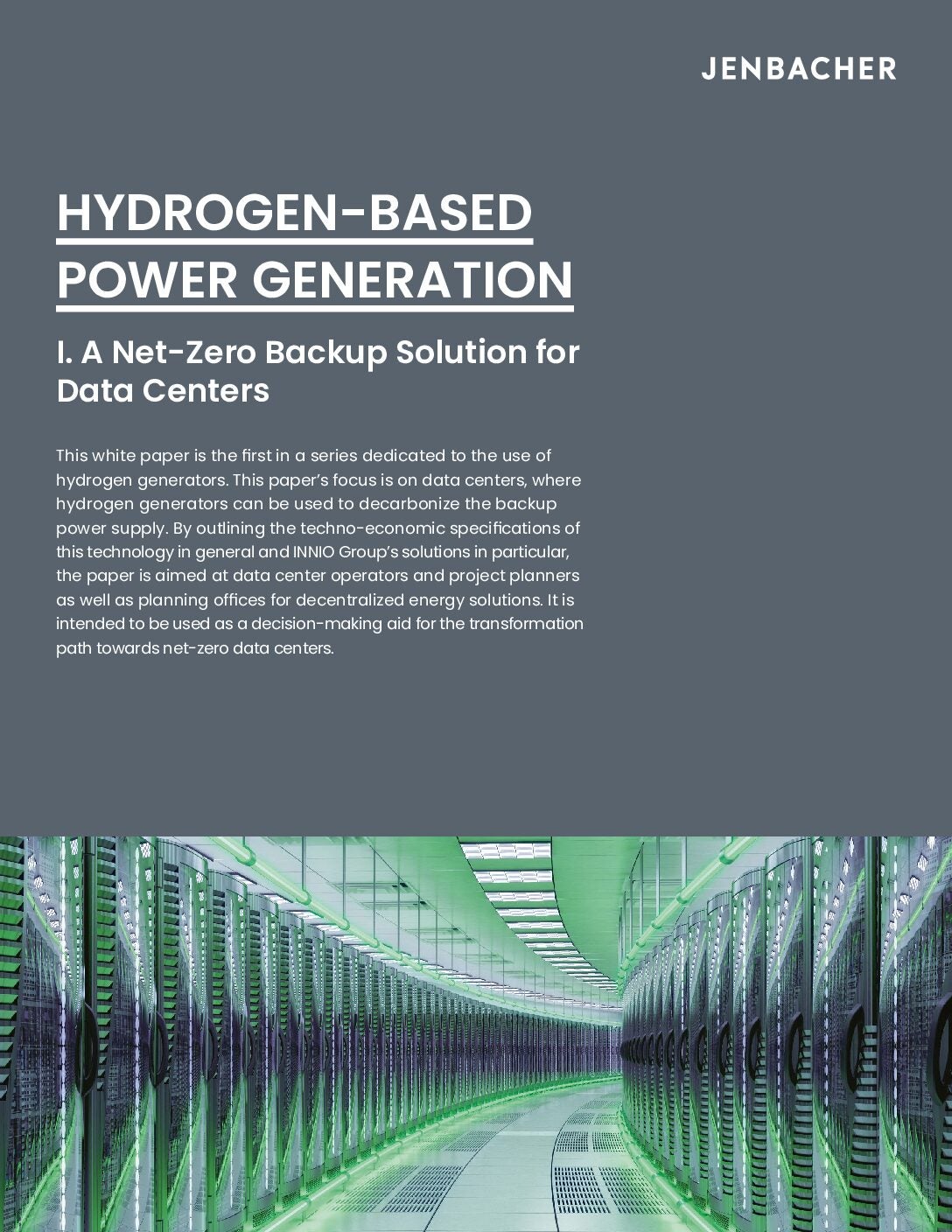
The rise of the data centre is one of the 21st century’s biggest technological developments, spurred on by the growth of big data, cloud computing, and more recently the advent of Artificial Intelligence (AI). Today, hyperscale warehouses, operated by tech giants such as Amazon, Google, Apple, Meta, and Microsoft, house thousands of servers designed to facilitate the storing and sharing of data.
According to forecasts from analytics firm GlobalData, the sector is only getting larger, with data centre revenues set to rise from a market value of $466bn in 2019 to $948bn by 2030, at a CAGR of 6.7%[i].
With demand for digital services still growing, data centres have become a critical part of our modern infrastructure, and operators are increasingly looking to improve energy efficiency and cost savings by investing in innovative equipment.

Many data centres are already powered by sustainable sources such as wind or solar. However, should the connection to this grid fail, the data centre needs emergency power generators that kick in to keep the centre running and protect equipment.
Until now, that need has mainly been met with diesel generators. However, green hydrogen – made using renewable energy sources to separate hydrogen atoms from water – is being touted as a clean and environmentally friendly alternative.
Decarbonising data centres
In the event of grid power failure, protecting equipment from damage falls to the uninterruptible power supply (UPS) which is a crucial component in maintaining power in IT systems. This is usually a lithium-ion battery system that is kept charged and on standby, often powered by solar energy. However, it is a short-term solution and can only support IT equipment without a cooling system for five to 15 minutes.
High-performance computing systems overheat quickly, leading to shutdowns, but investing in batteries that last longer than 15 to 30 minutes is uneconomical. The cooling system determines the data centre’s ability to operate after a power failure and most systems will switch to backup generators within a few minutes of an outage. Backup systems must be tested and maintained regularly to ensure that they function properly during a power outage to prevent server downtime.
Natural gas generators, which can also be fuelled with up to 100% hydrogen, are emerging as a viable alternative to diesel generators due to their high energy density and long-duration power generation. They offer fast response time during grid outages and are scalable, allowing data centres to customise their backup systems to specific power requirements. Further, generators running on 100% hydrogen emit only water vapour as a byproduct, reducing emissions and mitigating the environmental impact of data centre operations. Using green hydrogen will allow operators to become carbon-free in the future.
INNIO Group’s Jenbacher energy solutions are leading in this space, offering a range of effective emergency backup options. The company offers a highly efficient Jenbacher gas generator in the 3MW class with a super-fast start option for data centre applications that can take on load within 15 seconds and reach full load in under 45 seconds. INNIO Group’s Jenbacher gas generators with a fast-start option offer diesel-like performance for emergency backup with the main advantage of reduced emissions.
Governments around the world are introducing initiatives such as the US Department of Energy’s Hydrogen Shot, which aims to reduce the cost of clean hydrogen by 80% to $1 per 1kg over the next decade in order to compete with natural gas prices. GlobalData predicts that green hydrogen production will dominate the market with an estimated production capacity of 160,001ktpa by 2030,[ii] and with technological advancement, the cost of production should continue to fall.
Sustainable solutions for backup power generation
Today’s data centres are looking increasingly into sustainable backup energy supply. The NorthC project, featuring the world’s first 100% hydrogen backup power supply, is a pioneering example.
NorthC, a data centre company based in the Netherlands, was founded in 2019. It now owns a portfolio of almost twenty data centres across the Netherlands, Germany, and Switzerland. Totalling around 80,000 square metres of space, each centre is powered by 100% climate friendly energy. NorthC plans to be fully carbon neutral by 2030, so when looking for an emergency backup power solution for its data centre in Eindhoven, NorthC opted for a solution to match its net zero aims, choosing INNIO Group’s Jenbacher “Ready for H2”* technology.
INNIO Group’s “Ready for H2” platform enables the reduction of environmental impact while providing long-duration, high-energy-density power, making it an excellent solution for future data centre backup power needs. NorthC says hydrogen technology will reduce emissions of their backup power solutions by more than 80%[iii] and contribute significantly to its sustainability goals.
The six Jenbacher Type 4 hydrogen generators were delivered as a containerised package and generate a total power output of 6 megawatts. Configured as dual-gas generators these generators are capable of running on 100% natural gas, 100% H2, or mixtures of natural gas and hydrogen This future proofed technology has been commissioned in December 2023 and January 2024. In case of electricity grid outage, the generators can be operated either natural gas or hydrogen or any admixture. Meanwhile, INNIO Group’s AI-powered myPlant Performance digital platform solution provides secure, real-time monitoring of the emergency backup solution.
The Jenbacher “Ready for H2” engine portfolio offers the key advantage of fuel flexibility while helping to protect customers from stranded investments in their decarbonisation strategy. All new Jenbacher power plants are “Ready for H2” and engine variants with a corresponding option can be operated with up to 25% (vol) of H2 in the natural gas. As hydrogen availability increases, all new plants and most of the currently installed Jenbacher natural gas-powered units can be converted to operate on up to 100% hydrogen. INNIO Group’s Jenbacher product portfolio is already offered in the 1-MW-class for 100% hydrogen operation. In 2025, the portfolio can be offered up to 4 MW.
Get ahead of the competition and find out more about hydrogen-based power generation in the free, in-depth report below.
* In general, “Ready for H2” Jenbacher units can be converted to operate on up to 100% hydrogen in the future. Details on the cost and timeline for a future conversion may vary and need to be clarified individually.
[i] GlobalData: Thematic Research: Technology Data Centers, March 2024, page 17 [ii] GlobalData: Thematic Intelligence Power, January 9, 2024, Hydrogen in Power, page 21 [iii] https://www.northcdatacenters.com/en/northc-installs-europes-first-emergency-power-facilities-that-run-on-green-hydrogen-in-groningen/



